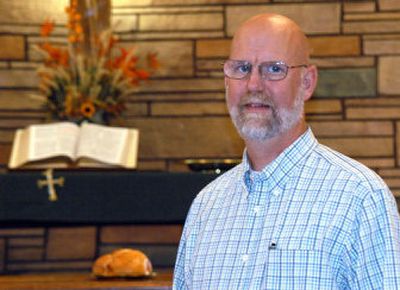Shared minister

With farms and agricultural businesses consolidating, economic realities have cultivated cooperation among rural Inland Northwest churches, too.
Two years ago, the Lutheran and Presbyterian churches in Fairfield, a town of 590 people 35 miles south of Spokane, chose to call one minister: the Rev. Paul Anderson, a Lutheran.
To foster a spirit of shared ministry, Anderson answers the phone at the Presbyterian church by saying, “First Presbyterian and Zion Lutheran,” and the reverse when he’s in Zion’s office.
“When someone from the Lutheran church apologized for calling me at the Presbyterian church, she asked if she should wait to call the next day at ‘our church,’ ” he recalls. “I said, ‘I’m your pastor all the time.’ “
Similarly, his business card is double-sided, with the logos of each denomination.
Says Anderson: “We can live out that we have one Lord, one faith and one baptism, as Ephesians says.”
By visiting people, learning about their needs and responding to them, he has helped both of the churches grow numerically and spiritually since his arrival in July 2004.
First Presbyterian had seven baptisms and added nine members last year. Zion added eight members and had 12 baptisms.
If someone comes to the Lutheran church and does not like the liturgy, Anderson may encourage them to try the Presbyterian church, or vice versa. About 40 people attend each church.
Declining memberships in both congregations led to financial woes and the need for joint efforts.
“I could see it was a matter of time,” says Karl Felgenhauer, the Presbyterian treasurer for six years.
Zion’s full-time minister left seven years ago. To save money, the church hired a part-time interim pastor, George Lacey, a retired Presbyterian minister in Coeur d’Alene.
In 2003, First Presbyterian’s pastor left and a group began talking about combining forces to call one pastor.
Nationally, Lutherans and Presbyterians, along with the United Church of Christ and the Reformed Church in America, established full communion through a Formula of Agreement the church bodies adopted in the 1990s.
Meanwhile, Anderson was completing a degree at Wartburg Theological Seminary in Dubuque, Iowa, which shared a bookstore, classes and professors with a sister seminary for Presbyterians and Methodists.
Impressed with ecumenical encounters there, he wrote in his profile of his desire to “do ecumenical work to bring denominations together in a community.”
When Anderson learned of the Fairfield situation, he says, he believed that “God was weaving a masterpiece.” After he and his wife, Gwen, visited for his interview in April 2004, both felt at home.
First Presbyterian pays Zion half of Anderson’s salary package, then Zion writes his full paycheck.
“It made sense to share a pastor so we can offer a salary and benefits package to draw a pastor and provide a good livelihood,” says Glenn Leitz, a lifelong Zion Lutheran member.
“I envision moving ahead, not going back, even if both churches grow.”
Because both churches are freed from having the bulk of their budgets tied up in pastors’ salaries, they can think about using more of their funds for mission work – to help local families as well as address global hunger and other needs.
The churches started a food bank within the last two years that has expanded to several communities. The Seventh Day Adventist Church in Fairfield, the Grange, Latah Country Bible Church and Waverly Community Church also are involved.
Food comes from Second Harvest and local donations. On Sunday, area youths will have their third annual Hayride Food Drive to collect food.
“We put youth on a wagon with some bales of hay and pull it with a tractor,” says Anderson, who calls it a way for young people to learn about helping others.
“It also instills that we all worship one God,” he says. “We are different churches but can share experiences, rather than arguing about petty differences.”
Anderson preaches basically the same sermon at both Zion Lutheran and First Presbyterian, keeping the theology true to each church.
“I’m aware that for Presbyterians Christ is present at the meal in the Eucharist, but for the Lutherans Christ is in the meal, the bread and wine are the body and blood of Christ,” he says. “I honor each faith, not watering either down.”
Another difference is that the Presbyterian congregation says the Lord’s prayer with “debts,” while the Lutherans say it with “trespasses.” In joint services, they use “sins.”
The churches rotate worship services three times a year. The service is at 8:30 a.m. at the Presbyterian church and 11 a.m. at the Lutheran church through December. From January to May, Lutherans will have the early service and Presbyterians, the later one. Next summer, Presbyterians will again worship early and Lutherans later.
Besides the normal services in the summer, the churches have a joint service one Sunday a month, in June at the community center and in July and August in the park, followed by potlucks. Afterward, they stay around to visit.
“We are getting to know the Lutherans as people,” Felgenhauer says. “The more we talk, the more we know about each other. It’s another avenue to meet and has an impact on community life.”